Hell Creek Formation
The Hell Creek Formation is an intensively-studied division of mostly Upper Cretaceous and some lower Paleocene rocks in North America, named for exposures studied along Hell Creek, near Jordan, Montana. The formation stretches over portions of Montana, North Dakota, South Dakota, and Wyoming. In Montana, the Hell Creek Formation overlies the Fox Hills Formation. The site of Pompeys Pillar National Monument is a small isolated section of the Hell Creek Formation. In 1966, the Hell Creek Fossil Area was designated as a National Natural Landmark by the National Park Service.
| Hell Creek Formation Stratigraphic range: Maastrichtian–Danian (Lancian) ~66.8–66 Ma | |
|---|---|
 Exposure in the badlands near Fort Peck Reservoir | |
| Type | Geological formation |
| Unit of | Montana Group |
| Sub-units | Breien, Little Beaver Creek, Middle Sandstone & Pretty Butte Members |
| Underlies | Fort Union Formation |
| Overlies | Fox Hills Formation |
| Thickness | 50–100 m (160–330 ft) |
| Lithology | |
| Primary | Claystone, mudstone |
| Other | Sandstone, siltstone, conglomerate, amber |
| Location | |
| Coordinates | 46.9°N 101.5°W |
| Approximate paleocoordinates | 52.6°N 74.4°W |
| Region | Montana, North Dakota, South Dakota, Wyoming |
| Country | |
| Extent | Williston Basin |
| Type section | |
| Named for | Hell Creek, Jordan, Montana |
| Named by | Barnum Brown |
| Year defined | 1907 |
 Hell Creek Formation (the United States)  Hell Creek Formation (Montana) | |

It is a series of fresh and brackish-water clays, mudstones, and sandstones deposited during the Maastrichtian and Danian (respectively, the end of the Cretaceous period and the beginning of the Paleogene) by fluvial activity in fluctuating river channels and deltas and very occasional peaty swamp deposits along the low-lying eastern continental margin fronting the late Cretaceous Western Interior Seaway. The climate was mild, and the presence of crocodilians suggests a sub-tropical climate, with no prolonged annual cold. The famous iridium-enriched Cretaceous–Paleogene boundary, which separates the Cretaceous from the Cenozoic, occurs as a discontinuous but distinct thin marker bedding above and occasionally within the formation, near its boundary with the overlying Fort Union Formation.
The world's largest collection of Hell Creek fossils is housed and exhibited at the Museum of the Rockies, in Bozeman, Montana. The specimens displayed are the result of the museum's Hell Creek Project, a joint effort between the museum, Montana State University, the University of Washington,[1] the University of California, Berkeley, the University of North Dakota, and the University of North Carolina which began in 1998.
Description
The Hell Creek Formation is an intensively-studied geological formation of mostly Upper Cretaceous and some Early Paleocene rocks in North America, named for exposures studied along Hell Creek, near Jordan, Montana. The formation stretches over portions of Montana, North Dakota, South Dakota, and Wyoming. In Montana, the Hell Creek Formation overlies the Fox Hills Formation.
In 1966, the Hell Creek Fossil Area was designated as a National Natural Landmark by the National Park Service.[2]
Geology

The Hell Creek Formation in Montana overlies the Fox Hills Formation and underlies the Fort Union Formation, and the boundary with the latter occurs near the Cretaceous-Paleogene boundary (K-Pg), which defines the end of the Cretaceous period and has been dated to 66 ± 0.07 Ma old.[3] The 90 metres (300 ft) thickness of the formation is estimated to have been deposited in about 2 million years.[4] Fauna characteristic of the Hell Creek (Lancian land vertebrate age) are found as high as a few meters below the boundary.[5]
The K-Pg boundary is generally situated near the contact between the upper Hell Creek and the lower Ludlow member of the Fort Union Formation, though in some areas (e.g. in North Dakota) the boundary is well within the Ludlow Member, 3 metres (9.8 ft) above the boundary with the Hell Creek in some areas.[5] On the other hand, in some small regions of Montana, the Hell Creek Formation contains the K-Pg boundary, and extends slightly into the Paleogene.[6]
The Tanis site in North Dakota contains evidence of what is proposed to be a record of the effects of the Chicxulub meteorite impact – such as the chaotic mixing of fossil carcasses and a layer of glass tektites with associated impact impressions – deposited minutes to hours after the impact.[7][8][9]
Paleobiology

Many animals including dinosaurs lived in the Hell Creek Formation. Its location at the changing conjunction of the eastern coast of Laramidia and the adjacent western shallows of the Western Interior Seaway leads to fossils of both sea and terrestrial creatures. Vertebrates include dinosaurs, pterosaurs, crocodiles, champsosaurs, lizards, snakes, turtles, frogs and salamanders. Remains of fishes and mammals have also been found in the Hell Creek Formation. The formation has produced impressive assemblages of invertebrates (including ammonites), plants, mammals, fish, reptiles (including the lizard Obamadon), marine reptiles (including the marine reptiles like mosasaurs, plesiosaurs and sea turtles), and amphibians. Notable dinosaur finds include Tyrannosaurus and Triceratops, ornithomimids as well, caenagnathids like Anzu, a variety of small theropods, pachycephalosaurs, ankylosaurs, crocodylomorphs and squamates, including various animal fossils unearthed in the Hell Creek Formation. The most complete hadrosaurid dinosaur ever found, an Edmontosaurus, was retrieved in 2000 from the Hell Creek Formation and widely publicized in a National Geographic documentary aired in December 2007. A few bird, mammal, and pterosaur fossils have also been found. The teeth of sharks and rays are sometimes found in the riverine Hell Creek Formation, suggesting that some of these taxa were then, as now, tolerant of fresh water. The "Lancian" fauna is more similar overall phylogenetically to East Asian and Canadian/Alaskan faunas than most Campanian North American faunas. Fossil insects from inclusions found within amber are known.[10]
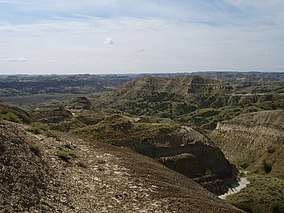
Depositional environment
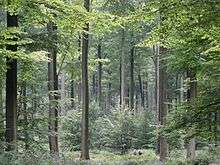
It is a series of fresh and brackish-water clays, mudstones, and sandstones deposited during the Maastrichtian and Danian (respectively, the end of the Cretaceous period and the beginning of the Paleogene) by fluvial activity in fluctuating channels and deltas and very occasional peaty swamp deposits along the low-lying eastern continental margin fronting the late Cretaceous Western Interior Seaway. The Hell Creek Formation, as typified by exposures in the Fort Peck area of Montana, has been interpreted as a flat, forested floodplain with a relatively subtropical climate that supported a variety of plants ranging from angiosperm trees to conifers such as the bald cypress, ferns and ginkgos. The Hell Creek Formation was laid down by streams, on a coastal plain along the edge of the Western Interior Seaway. The presence of crocodylians suggests climate was subtropical; there was no cold season and probably ample precipitation.
The Hell Creek Formation, Lance Formation and Scollard Formation represent different sections of the western shore of the shallow sea that divided western and eastern North America during the Cretaceous. Swampy lowlands were the habitat of various animals, including dinosaurs. A broad coastal plain extended westward from the seaway to the newly formed Rocky Mountains. These formations are composed largely of sandstone and mudstone which have been attributed to floodplain, fluvial, lacustrine, swamp, estuarine and coastal plain environments.[11][12][13] Hell Creek is the best studied of these ancient environments. At the time, this region had a subtropical, warm and moist climate. The climate was humid, with flowering plants, conifers, palmettos, and ferns in the swamps, and conifers, canopy, understory plants, ash trees, live oak and shrubs in the forests. In northwestern South Dakota, strips of black layers deposited in the wetland environment are rich in coal, and a bright band-like layer of sand and mud from the river floodplain accumulated. Many plant species were supported, primarily angiosperms, and less commonly conifers, bald cypress, ferns and cycads. An abundance of fossil leaves are found at dozens of different sites indicating that the area was largely forested by small trees.
Fossil content
Dinosaurs

A paleo-population study is one of the most difficult of analyses to conduct in field paleontology. Here is the most recent estimate of the proportions of the eight most common dinosaurian families in the Hell Creek Formation, based on detailed field studies by White, Fastovsky and Sheehan (1998).
- Ceratopsidae 61%
- Hadrosauridae 23%
- Ornithomimidae 5%
- Tyrannosauridae 4%
- Hypsilophodontidae 3%
- Dromaeosauridae 2%
- Pachycephalosauridae 1%
- Troodontidae 1% (represented only by teeth)
Outcrops sampled by the Hell Creek Project were divided into three sections: lower, middle and upper slices. The top and bottom sections were the focus of the PLoS One report, and within each portion many remains of Triceratops, Edmontosaurus, and Tyrannosaurus were found. Triceratops was the most common in each section, but, surprisingly, Tyrannosaurus was just as common, if not slightly more common, than the hadrosaur Edmontosaurus. In the upper Hell Creek section, for example, the census included twenty two Triceratops, five Tyrannosaurus, and five Edmontosaurus.
The dinosaurs Thescelosaurus, Ornithomimus, Pachycephalosaurus and Ankylosaurus were also included in the breakdown, but were relatively rare. Other dinosaurs, such as Sphaerotholus, Denversaurus, Torosaurus, Struthiomimus, Acheroraptor, Dakotaraptor, Pectinodon, Richardoestesia, Paronychodon, Anzu, Leptorhynchos and Troodon (more likely Pectinodon), were reported as being rare and are not included in the breakdown.
The dinosaur collections made over the past decade during the Hell Creek Project yielded new information from an improved genus-level collecting schema and robust data set that revealed relative dinosaur abundances that were unexpected, and ontogenetic age classes previously considered rare. We recognize a much higher percentage of Tyrannosaurus than previous surveys. Tyrannosaurus equals Edmontosaurus in U3 and in L3 comprises a greater percentage of the large dinosaur fauna as the second-most abundant taxon after Triceratops, followed by Edmontosaurus. This is surprisingly consistent in (1) the two major lag deposits (MOR loc. HC-530 and HC-312) in the Apex sandstone and Jen-rex sand where individual bones were counted and (2) in two thirds of the formation reflected in L3 and U3 records of dinosaur skeletons only.
Triceratops is by far the most common dinosaur at 40% (n = 72), Tyrannosaurus is second at 24% (n = 44), Edmontosaurus is third at 20% (n = 36), followed by Thescelosaurus at 8% (n = 15), Ornithomimus at 5% (n = 9), and Pachycephalosaurus and Ankylosaurus both at 1% (n = 2) are relatively rare.
Fossil footprints of dinosaurs from the Hell Creek Formation are very rare. As of 2017, there is only one find of a possible Tyrannosaurus rex footprint, dating from 2007 and described a year later.[14]
Eumaniraptorans
Historically, numerous teeth have been attributed to various dromaeosaurid and troodontid taxa with known body fossils from only older formations, including Dromaeosaurus, Saurornitholestes, and Troodon. However, in a 2013 study, Evans et al. concluded that there is little evidence for more than a single dromaeosaurid taxon, Acheroraptor, in the Hell Creek-Lance assemblages, which would render these taxa invalid for this formation. This was disproved in a 2015 study, DePalma et al., when they described the new genus Dakotaraptor, a large species of dromaeosaur.[15] Fossilized teeth of various troodontids and coelurosaurs are common throughout the Hell Creek Formation; the best known examples include Paronychodon, Pectinodon and Richardoestesia, respectively.
Flora
The Hell Creek Formation was a low floodplain at the time before the sea retreated, and in the wet ground of the dense woodland, laurels, sycamores, beech, magnolias, and palm trees grew. Ferns and moss grew in the forest understory. Plant fossils from the upper early Paleocene of the Hell Creek Formation include the ferns Botrychium, Woodwardia, Osmunda, Onoclea and Azolla; conifers Metasequoia, Glyptostrobus and cupressaceous conifers; the monocot Limnobiophyllum (a relative of duckweeds); and the dicots Cercidiphyllum and Platanus.[16][17] There are numerous types of leaves, seeds, flowers and other structures from Angiosperms, or flowering plants. The Hell Creek Formation of this layer contains 300 tablets or more of plants. Angiosperms are by far the most diverse and dominant flora of the entire population, about 90 percent. However, the evergreens included conifers, ginkgo, bald cypress, and cycads. Flowering plants included a variety of trees that no longer exist. Today Hell Creek's flora is hardwood forest mixed with deciduous and evergreen forest and apparently similar to then, but with a closer look, the current plant community is distinct. In sharp contrast to Montana today, the presence of palm trees meant the climate was warmer then.
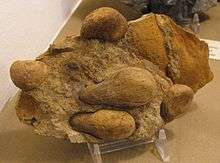
Dr. Kirk Johnson (Scientist) claims that there are no grasses, oaks, maples, or willows in the Hell Creek Formation. Ferns are uncommon in the majority of the formation, however there is a great increase in the abundance of fossil fern spores in the two centimeters of rock that directly overlies the impact fallout layer (the famous K-T boundary layer). This increase in fern spore abundance is commonly referred to as "the fern spike" (meaning that if the abundance of spores as a function of stratigraphic position were plotted out, the graph would show a spike just above the impact fallout layer). Johnson also found that the majority of the angiosperm genera in the Hell Creek Formation are now extinct. He also believes that, very roughly, 80% of the terrestrial plant taxa died out in what is now Montana and the Dakotas at the K/T boundary.
Many of the modern plant affinities in the Hell Creek Formation (e.g., those with the prefix "aff." or with quotes around the genus name) may not in reality belong to these genera; instead they could be entirely different plants that resemble modern genera. Therefore, there is some question regarding whether the modern Populus or Juglans, as two examples, actually lived in the late Cretaceous.
Compared to the rich Hell Creek Formation fossil plant localities of the Dakotas, relatively few plant specimens have been collected from Montana. A few taxa were collected at Brownie Butte Montana by Shoemaker, but most plants were collected from North Dakota (Slope County) and from South Dakota. "TYPE" after the binomial means that it is represented by a type specimen found in the Yale-Peabody Museum collections. "YPM" is the prefix for the Yale-Peabody Museum specimen number.
Overview (from Johnson, 1997): 190 plant morphotypes, including:
- 1 bryophyte (mosses and liverworts)
- 6 "pteridophytes" (A paraphyletic group: modern examples are horsetails, club mosses and ferns.)
- 9 conifers
- 2 ginkgo (uncommon)
- 172 angiosperms (90% of all specimens collected, as well as 90% of all taxa found)

- Ginkgo (uncommon)
 Various angiosperms
Various angiosperms
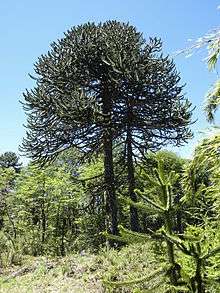 Monkey-puzzle leaves
Monkey-puzzle leaves Palm trees indicate a hotter paleoclimate
Palm trees indicate a hotter paleoclimate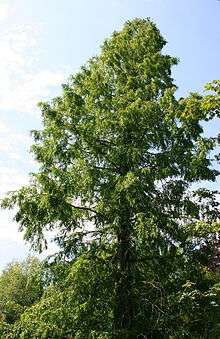 Redwood seed cones
Redwood seed cones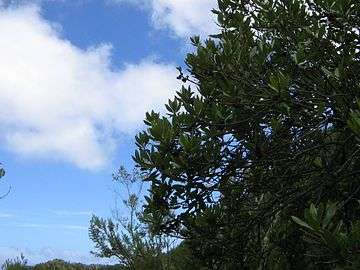
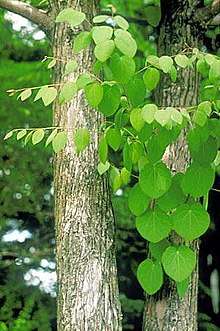
 Magnolia (common)
Magnolia (common)
- Plants of the Hell Creek Formation
- various ferns and cycads
- Equisetum (Equisetaceae)
- Platyspiroxylon (Cupressaceae)
- Podocarpoxylon (Podocarpaceae)
- Elatocladus (Taxodiaceae)
- Sequoiaxylon (Taxodiaceae)
- Taxodioxylon (Taxodiaceae)
- Araucaria (Araucariaceae)
- very widespread Mesozoic conifer group. All members are extinct (Cheirolepidiaceae)
- Artocarpus (Moraceae)
- Barberry family (Berberidaceae)
- Cercidiphyllum (Cercidiphyllaceae)
- Dombeyopsis (Sterculiaceae)
- Laurel family (Lauraceae)
- Magnolia (Magnoliaceae)
- Palms (Arecaceae)
- Platanus family includes today's American sycamore or plane tree (Platanaceae)
See also
- List of fossil sites (with link directory)
- Lists of dinosaur-bearing stratigraphic units
- Morrison Formation
- Cretaceous-Paleogene formations
- Denver Formation
- Ferris Formation
- Tremp Formation, Spain
- Lefipán Formation, Argentina
- Lopez de Bertodano Formation, Antarctica
References
- Wilson Lab
- U.S. National Park Service, 1966
- Husson et al., 2011
- LeCain, 2010
- Pearson et al., 2002
- Johnson et al., 2002
- DePalma et al., 2019
- Broad, 2019
- Preston, 2019
- DePalma, 2010
- Lofgren, 1997
- Breithaupt, 1997
- Eberth, 1997
- Manning et al., 2008
- Evans, 2013
- Chandrasekharam, 1974
- Christophel, 1976
Bibliography
- General
- Broad, William J., and Kenneth Chang. 2019. Fossil Site Reveals Day That Meteor Hit Earth and, Maybe, Wiped Out Dinosaurs. The New York Times. Accessed 2019-04-01. ISSN 0362-4331
- Preston, Douglas. 2019. The Day the Dinosaurs Died, 1. The New Yorker. Accessed 2019-04-01.
- U.S. National, Park Service. 1966. National Natural Landmarks - National Natural Landmarks (U.S. National Park Service), 1. www.nps.gov. Accessed 2019-03-22.
- Wilson, Lab. 2017. Hell Creek Project – Wilson Lab, 1. University of Washington. Accessed 2019-03-22.
- Geology
- DePalma, Smit J, Burnham DA, Kuiper K, Manning PL, Oleinik A, Larson P, Maurrasse FJ, Vellekoop J, Richards MA, Gurche L and Walter Alvarez W, R.A. 2019. A seismically induced onshore surge deposit at the K-Pg boundary, North Dakota. Proceedings of the National Academy of Sciences 116. 8190–8199. Accessed 2020-03-30. doi:10.1073/pnas.1817407116 PMID 30936306 PMC 6486721 Bibcode: 2019PNAS..116.8190D
- Evans, D.C.; D.W. Larson, and P.J. Currie. 2013. A new dromaeosaurid (Dinosauria: Theropoda) with Asian affinities from the latest Cretaceous of North America. Naturwissenschaften 100. 1041–1049. doi:10.1007/s00114-013-1107-5 Bibcode: 2013NW....100.1041E PMID 24248432
- Husson, D.; B. Galbrun; J. Laskar; L.A. Hinnov; N. Thibault; S. Gardin, and R.E. Locklair. 2011. Astronomical calibration of the Maastrichtian (late Cretaceous). Earth and Planetary Science Letters 305. 328–340. doi:10.1016/j.epsl.2011.03.008 Bibcode: 2011E&PSL.305..328H
- LeCain, Rebecca. 2010. Magnetostratigraphy of the Hell Creek and lower Fort Union formations in northeast Montana, 1. Master's Theses and Capstones. Accessed 2020-03-30.
- Johnson, K.R.; D.J. Nichols, and J.H. Hartman. 2002. Hell Creek Formation: A 2001 synthesis. The Hell Creek Formation and the Cretaceous-Tertiary Boundary in the northern Great Plains. Geological Society of America Special Paper 361. 503–510.
- Paleontology
- DePalma, Robert. 2010. Preliminary Notes on the First Recorded Amber Insects from the Hell Creek Formation. The Journal of Paleontological Sciences x. x. Accessed 2019-02-21.
- Boyd, Clint A.; Caleb M. Brown; Rodney D. Scheetz, and Julia A. Clarke. 2009. Taxonomic revision of the basal neornithischian taxa Thescelosaurus and Bugenasaura. Journal of Vertebrate Paleontology 29. 758–770. doi:10.1671/039.029.0328
- Longrich, N. 2008. A new, large ornithomimid from the Cretaceous Dinosaur Park Formation of Alberta, Canada: Implications for the study of dissociated dinosaur remains. Palaeontology 54. 983–996. doi:10.1111/j.1475-4983.2008.00791.x
- Manning, P.L.; C. Ott, and P.L. Falkingham. 2008. The first tyrannosaurid track from the Hell Creek Formation (Late Cretaceous), Montana, U.S.A. PALAIOS 23. 645–647. doi:10.2110/palo.2008.p08-030r Bibcode: 2008Palai..23..645M
- Bakker, R.T.; R.M. Sullivan; V. Porter; P. Larson, and S.J. Saulsbury. 2006. Dracorex hogwartsia, n. gen., n. sp., a spiked, flat-headed pachycephalosaurid dinosaur from the Upper Cretaceous Hell Creek Formation of South Dakota in Lucas, S. G. and Sullivan, R. M., eds., Late Cretaceous vertebrates from the Western Interior. New Mexico Museum of Natural History and Science Bulletin 35. 331–354. Accessed 1907-10-31.
- Henderson, M.D., and J.E. Peterson. 2006. An azhdarchid pterosaur cervical vertebra from the Hell Creek Formation (Maastrichtian) of southeastern Montana. Journal of Vertebrate Paleontology 26. 192–195. doi:10.1671/0272-4634(2006)26[192:aapcvf]2.0.co;2
- Weishampel, David B.; Peter Dodson, and Halszka Osmólska (eds.). 2004. The Dinosauria, 2nd edition, 1–880. Berkeley: University of California Press. Accessed 2019-02-21. ISBN 0-520-24209-2
- Pearson, D.A.; T. Schaefer; K.R. Johnson; D.J. Nichols, and J.P. Hunter. 2002. The Hell Creek Formation and the Cretaceous-Tertiary boundary in the northern Great Plains: An integrated continental record of the end of the Cretaceous. Vertebrate Biostratigraphy of the Hell Creek Formation in Southwestern North Dakota and Northwestern South Dakota, Geological Society of America Special Paper 361. 145–167. Accessed 2019-03-22. ISBN 9780813723617
- Varricchio, D.J. 2001. Late Cretaceous oviraptorosaur (Theropoda) dinosaurs from Montana, 42–57. D. H. Tanke and K. Carpenter (eds.), Mesozoic Vertebrate Life. Indiana University Press, Indianapolis, Indiana.
- Currie, P.J., and K. Padian. 1997. The Encyclopedia of Dinosaurs, 1–901. Academic Press. Accessed 2020-03-30. ISBN 978-0-122-26810-6
- Eberth, D.A. (1997). "Edmonton Group". San Diego: Academic Press. pp. 199–204. ISBN 978-0-122-26810-6.
- Lofgren, D.F. (1997). "Hell Creek Formation". San Diego: Academic Press. pp. 302–303. ISBN 978-0-122-26810-6.
- Breithaupt, B.H (1997). "Lance Formation". San Diego: Academic Press. pp. 394–395. ISBN 978-0-122-26810-6.
- Christophel, D.C.. 1976. Fossil floras from the Smoky Tower locality, Alberta, Canada. Palaeontographica, Abt. B 157. x.
- Chandrasekharam, A.. 1974. Megafossil flora from the Genesee locality, Alberta, Canada. Palaeontographica, Abt. A, 174. x.
- Estes, R., and P. Berberian. 1970. Paleoecology of a late Cretaceous vertebrate community from Montana. Breviora 343. 1.
Further reading
- Bryant, L.J. 1987. A new genus and species of Amiidae (Holostei; Osteichthyes) from the Late Cretaceous of North America, with comments on the phylogeny of the Amiidae. Journal of Vertebrate Paleontology 7. 349–361. Accessed 2020-03-30.
- Archibald, J.D. 1982. A study of Mammalia and geology across the Cretaceous-Tertiary boundary in Garfield County, Montana. University of California Publications in Geological Sciences 122. 1–28.
- Brown, Barnum, and Erich Maren Schlaikjer. 1943. A study of the troödont dinosaurs with the description of a new genus and four new species. Bulletin of the American Museum of Natural History 82. 115–150. Accessed 2020-03-30.
- Osborn, Henry Fairfield. 1910. Department of Vertebrate Palaeontology. Annual Report of the American Museum of Natural History of the Year 1909 41. 71–72. Accessed 2020-03-30.
- Anonymous, author. 1907. Department of Vertebrate Palaeontology; field expeditions of 1906. The American Museum Journal 7. 6–8. Accessed 2020-03-30.
- Brown, Barnum. 1907. The Hell Creek Beds of the Upper Cretaceous of Montana: their relation to contiguous deposits, with faunal and floral lists and a discussion of their correlation. Bulletin of the American Museum of Natural History 23. 823–845. Accessed 2020-03-30.
- Anonymous, author. 1905. Department of Vertebrate Paleontology. The American Museum Journal 5. 9–11. Accessed 2020-03-30.
- Beasley, Walter L. 1903. A remarkable fossil discovery. Scientific American 89. 87. Accessed 2020-03-30.
- Cope, Edward Drinker. 1883. The structure and appearance of a Laramie dinosaurian. American Naturalist 17. 774–777.
